A Couple Ivermectin Takedowns
Tagged:COVID
/
JournalClub
/
MathInTheNews
/
PharmaAndBiotech
/
Statistics
The right-wing knuckleheadedness around ivermectin as a COVID-19 therapy continues to amaze me. This week I came across 2 ivermectin takedowns: a Malaysian clinical trial and Scott Alexander’s dissection of the ivmmeta.com metanalysis. Two thumbs down. Way down.
OK, why are people so shouty about this ivermectin stuff?
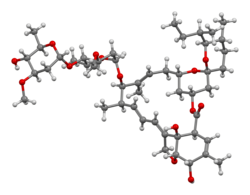 Ivermectin is a drug used to treat
infestations of non-vertebrate parasites (think intestinal worms, or a topical lotion for
head lice).
Ivermectin is a drug used to treat
infestations of non-vertebrate parasites (think intestinal worms, or a topical lotion for
head lice).
It has mostly veterinary applications in the US, since farm animals get worms regularly, but people rarely do. But that’s not the case everywhere, and even in the US people occasionally get worms and need treatment. That’s what ivermectin does, and does very well.
I’m going to vent a certain amount of invective about ivermectin here, but don’t get me wrong: it’s a perfectly fine drug, in the case of parasite infestations. Campbell & Omura even got the 2015 Nobel in medicine for its discovery in the 1970s. It’s even on the WHO’s list of essential medicines. If you have worms, ivermectin is your new best friend. If you don’t, then not.
So please understand: my animus on the subject is not about ivermectin for the usual applications, where it’s just fine; rather, it’s about knuckleheads spreading disinformation that it’s a COVID-19 cure. Belief in that nonsense kills people.
But… COVID-19?
 It’s gotten so bad that the FDA has to put out consumer updates like the one shown here
[1] reminding you not to go to your farm supply store and
take horse paste. We shouldn’t need to be told that, but (as all the existentialists say)
here we are, nonetheless. Probably people who buy into this sort of conspiracy theory won’t trust
the FDA or even notice the consumer update, but the FDA’s trying to be responsible here.
It’s gotten so bad that the FDA has to put out consumer updates like the one shown here
[1] reminding you not to go to your farm supply store and
take horse paste. We shouldn’t need to be told that, but (as all the existentialists say)
here we are, nonetheless. Probably people who buy into this sort of conspiracy theory won’t trust
the FDA or even notice the consumer update, but the FDA’s trying to be responsible here.
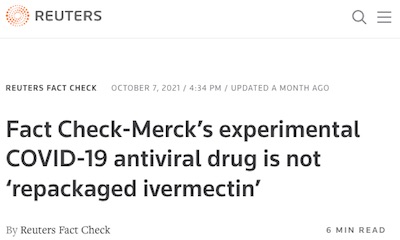
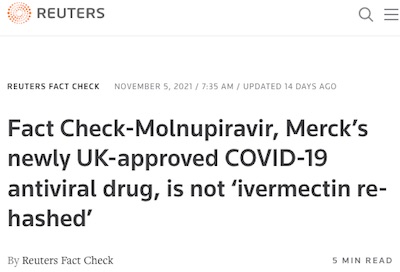 People are so suspicious and deluded that
when Merck announced the success of the molnupiravir trial,
people immediately dived down the intellectual rathole of speculation that molnupiravir is
just repackaged ivermectin (because Merck makes both, and ivermectin is a cheap generic,
thus less profitable).
People are so suspicious and deluded that
when Merck announced the success of the molnupiravir trial,
people immediately dived down the intellectual rathole of speculation that molnupiravir is
just repackaged ivermectin (because Merck makes both, and ivermectin is a cheap generic,
thus less profitable).
It was so bad, and so immediate, that Reuters ran 2 Fact Checks on it. Ivermectin and molnupiravir are just not even remotely similar [2] [3]:
- Ivermectin is a macrolytic lactone derived from a bacterium, acting on glutamate-gated chloride ion channels found all over in worms and insects. Wedge those channels open, the chloride ions flow freely, hyper-polarizing the membrane involved, which paralyzes and kills the parasite. In humans, the only such channels are in the brain and spinal cord, but ivermectin can’t pass the blood-brain barrier (at normal dose levels).
- Molnupiravir is a nucleotide that’s been messed with chemically so it won’t function properly, and operates by getting incorporated in the viral RNA as it replicates so it hypermutates and can’t function.
Not even remotely similar! Also, ivermectin’s mechanism has nothing to do with viruses.
We’ve previously whinged a bit about ivermectin nonsense on this crummy little blog that nobody reads, but today we’ll look at some more serious takedowns from real clinical trials analyzed by people with real medical credentials.
And what does de-worming have to do with COVID-19?
Umm… I dunno. Plumbing the depths of the right-wing disinformation sewer to find the origin is something that will have to be done by somebody with a stronger stomach than me. I get angry too fast, because putting this sort of crap in people’s head kills them.
The recent Malaysian clinical trial
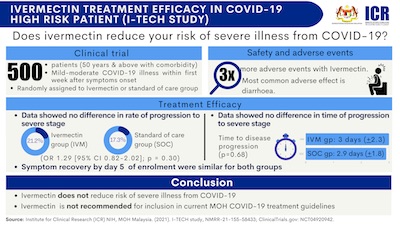 Earlier this month, the Ministry of Health in Malaysia released the results of a clinical
trial of ivermectin vs standard of care in COVID-19
patients. [4] (The US registry is
NCT04920942, if you want to see all
the details.)
Earlier this month, the Ministry of Health in Malaysia released the results of a clinical
trial of ivermectin vs standard of care in COVID-19
patients. [4] (The US registry is
NCT04920942, if you want to see all
the details.)
Why Malaysia? Because ivermectin is generic, and therefore cheap. That makes a huge difference in the developing world. However, sensible people want to know if ivermectin is actually useful, so they ran a trial.
The summary is shown here:
- Design:
- Population: 500 subjects, over age 50, some with co-morbidities. So they’re (properly) studying the population that most needs help.
- Mild to moderate COVID-19, began treatment within 1 week after onset of symptoms. So they’re (properly) looking for an early intervention to prevent serious disease or death.
- Randomly assigned ivermectin or standard of care. So they’re (properly) randomizing. (I think: there are a lot of details to proper randomization which are left out of the summary. But everything looks good on the surface.)
- Results:
- 3x more adverse events in the ivermectin arm, the most common being severe diarrhea. (Bonus points for the diarrhea cartoon on the center right.)
- No difference in progression to severe disease (21.2% on ivm, 17.3% on SoC). That gives a risk ratio of 1.29 against ivermectin. But the 95% confidence interval on the risk ratio is 0.82 – 2.02: since that interval includes 1 (i.e., the same risk in both arms), this is not significant.
- No difference in the time to severe stage either: 3.0 vs 2.9 days. They quote a p-value, which I assume is a t-test of mean difference between the two groups, of p=0.68, which is wildly non-significant.
So ivermectin had worse side-effects, didn’t stop severe disease, and didn’t even slow it down. That’s damning enough, but there’s more: they measured ICU admission, mechanical ventilation, symptom recovery, blood parameters and chest x-ray resolution… and saw no difference there, either.
Conclusion: Ivermectin is a bad choice of COVID-19 therapeutic.
Taking stock of ivmmeta.com
But apparently there are studies that favor ivermectin. Unfortunately, a lot of them are misdesigned, misinterpreted, or just outright fraudulent. A couple weeks ago we favorably quoted the skeptical frustration of Ashish Jha, head of the Brown University School of Public Health:
That was just one study. At ivmmeta.com, they’ve done a meta-analysis (combining mulitple other studies to get better statistical significance) of 66 studies and found ivermectin is wonderful.
Today, we read through a dissection of that meta-analysis by Scott Alexander Siskind, who gets my award for Best Blogger Ever. [5] Let’s see what Scott has to say, and maybe add on a few little bits of our own.
Weirdness #1: Anomalous Anonymity
The first thing he notes about ivmmeta is that it’s big, it’s detailed, it’s professional-looking… but it’s anonymous. Why would you perform thousands of work hours like this, hoping to change the world of COVID-19 therapeutics, and not put your name on it?
It seems kind of trollish to me: if you hope to change the world for the better, you want your name on it so you can claim credit; if you’re just stirring up trouble with disinformation, you want anonymity and plausible deniability.
(Yes, this blog is hemi-semi-demi-anonymous. That’s to repel annoyances. And, of course, because I’m not trying to make a dramatic splash that changes how everybody thinks. I want to examine how I think, and talk it over with friends and the occasional passers-by who somehow find their way to this crummy little blog that nobody reads.)
The forest plot
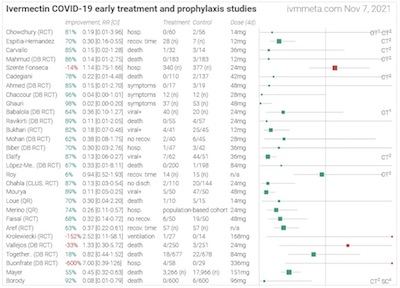 Scott starts off in the right place: the
forest plot (a.k.a. “blobbogram”)
of 35 ivermectin studies, summarizing them:
Scott starts off in the right place: the
forest plot (a.k.a. “blobbogram”)
of 35 ivermectin studies, summarizing them:
- Each line is a study.
- The first numbers on the left are the Risk Ratio (RR: ratio of probability of the endpoint in ivermectin vs other arm) and its confidence limit. You’d like to see RR<1 to see a positive ivermectin effect.
- The plot on the right shows the same sort of thing visually: RR increases horizontally from the left (RR<1) to the right (RR>1). The box shows you where the RR estimate is, the size of the box indicates the number of patients, and the whiskers show the confidence interval.
- For ivermectin to be successful, you’d like to see a lot of big green boxes all to the left, with confidence interval whiskers that don’t reach up to 1 (the vertical gray line).
And because that’s what you see here, it needs investigating to see if it’s real.
Weirdness #2: Muddled Measures
The meta-analysis is a bit screwy on a number of grounds, one of which is they use different endpoints from different studies: death, hospitalization, recovery time, having symptoms, ventilation, not being discharged from hospital… basically all over the map! What these guys did was pick the most dire outcome reported by each study, and tried to combine them.
You cannot combine different measures like this and expect to get anything but hash at the other end.
Weirdness #3: Insane Inclusion
Each of the studies has different criteria for who can be a subject, what to measure, what counts as COVID-19, what counts as progress, and so on. Normally in a meta-analysis, you either (a) combine studies that do the same thing or at least similar things, or (b) you use a more or less objective set of rules like Cochrane GRADE.
The authors of ivmmeta.com do neither. They just include whatever they want, and tell us to trust their judgement because they’ve read all the studies carefully. Given the amount of fraudulent studies on ivermectin, this makes absolutely no sense whatsoever!
It introduces the potential for investigator bias that contaminates everything.
The long, hard grind
Scott then went through each of the 35 studies, read the primary material, and found all sorts of crap. For example, some studies were actually fraudulent. Some, once you got the raw data, showed craziness: patients dying before the study started, groups of 4 patients repeatedly looking like the data was copy/pasted… basically enough to convince you the study never happened at all. At least 4 studies have been retracted because of data fraud.
Scott has the stamina and guts to go through all the studies; I can’t even fight my way through more than half of his writeup. It’s just too depressing. If it’s not fraudlent, it’s incompetent. If it’s not incompetent, it’s underpowered. If it’s not underpowered, it’s just mis-analyzed. If it’s not mis-analyzed, it wasn’t randomized or blinded.
Sometimes they reported numbers that simply could not be the result from a patient population they claimed. Simple example: if you have 10 patients, there’s no way you can say 15% of them did something or other – 0.15 is not the result of any integer fraction with a denominator of 10. Is that incompetence, or fake data? (And at this point, does it matter which?)
Some of the studies even have treatment and control groups done at different times, which means they were exposed to different strains of SARS-CoV-2 (Delta vs other)! That is, not to put to fine a point on it, utter madness. Have they ever even met a statistician?!
Just a real mess.
Between Scott’s analysis and another by Gideon Meyerowitz-Katz, who investigated these for fraud, they eliminated 18 out of 29 studies. The eliminations were for fraud, for severe preregistration violations (not saying what you’re measuring in advance, but just going on a fishing expedition), methodological blunders, and so on.
Weirdness #4: Silly Significance
Finding this much fraud and incompetence in one place would be enough for me to just throw out everything. That’s because the rest have a pretty good chance of being fraudulent or incompetent, just in a way I didn’t find out. But then, I’m a cranky old statistician.
But Scott is younger man who has more faith in humanity than me. So he persisted. After removing 2/3 of the studies for incompetence or fraud, that cuts the forest plot down to this:

Sure, it looks like there’s lots of green boxes, favoring ivermectin. But of the 11 studies, exactly one study (Bukhari) has a 95% confidence interval that keeps the risk ratio below 1. All the others are marginal at best!
Now, what’s your feeling here? When we have to dig deeply to throw out 2/3 of the studies for incompetence or fraud, and of the remainder only 1 has robust enough statistical significance to pass muster? Doesn’t it seem like maybe that significance is an accident? Why is it when trying to combine large numbers of studies in a meta-analysis, before we even get to the “meta” part, we’re back down to one study?
If that doesn’t smell bad to you, get your doc to check you for COVID-19 because you’ve lost your sense of smell. Sure, maybe the meta-analysis of all of them combined might be significant, but at this point it had better be really convincing. (And the fact that they already use different endpoints and inclusion criteria isn’t helping.)
You can fiddle about with the inclusion criteria, the outcome measures, and the combination methods to get results from p∼0.04 to p∼0.15. I.e., if you try really hard to manipulate the questions you ask, you can get borderline statistical significance (just below 0.05). There’s a name for this practice of fiddling around to find the post hoc question your data says is significant: p-hacking. And it’s a crime against statistics.
Weirdness #5: Wait, Worms?

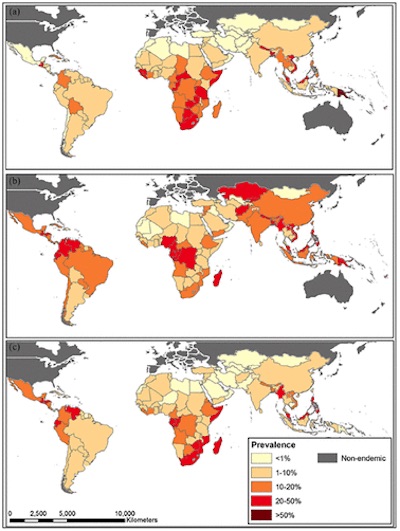 But now the best part!
But now the best part!
Scott points out that the studies showing even just a trend toward significance come from countries with something in common: Mahmud from Bangladesh, Ravakirti from East India, Lopez-Medina from Colombia, etc. all come from countries with a large amount of intestinal parasitic worms. The maps here are from the Riaz paper [6] that Scott cites.
Recall that ivermectin is for de-worming animals and people.
Basically:
- Having intestinal worms makes everything worse, including COVID-19. Ivermectin gets rid of those worms, so ivermectin helps only if you were already parasitized by worms to begin with.
- Many of the treatments for COVID-19 involve anti-inflammatories, mostly corticosteroids like dexamethasone. Those shut down some parts of the immune system that fight worms, letting the worms run riot in your gut while you’re sick of COVID-19. Worm hyperinfection alone can be fatal; imagine how much worse it is to have COVID-19 at the same time. So again, ivermectin helps if and only if you already have worms.
- Worms have a variety of ways of turning down your immune system so they can parasitize you at their leisure; it’s likely some of those also reduce vaccine efficacy and response to SARS-CoV2 infection. Ivermectin makes vaccination or response to infection better, provided you’re already being harassed by intestinal worms in the first place.
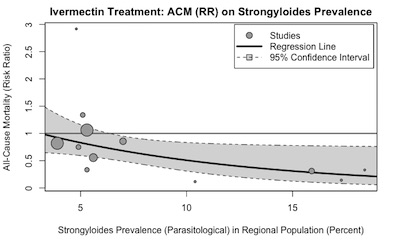 The final nail in the coffin… well, let’s be honest: it’s really more of a railroad
spike, isn’t it? Avi Bitterman controlled the ivermectin results for percent of
population with Strongyloides worm infestation and
reported the result shown here.
The final nail in the coffin… well, let’s be honest: it’s really more of a railroad
spike, isn’t it? Avi Bitterman controlled the ivermectin results for percent of
population with Strongyloides worm infestation and
reported the result shown here.
The horizontal axis is the fraction of the population at risk for infestation by Strongyloides stercoralis, a parasitic worm. The vertical axis is the Risk Ratio for all-causes mortality in an ivermectin COVID-19 trial, with low values being favorable to ivermectin.
Each gray circle is a study, diameter indicating the size. Note this very, very carefully: all the studies reporting ivermectin effect were in regions at risk for worm infestations, and were small studies.
The Weekend Conclusion
Ivermectin is for worms. If you have – or think you might have – worms, see your doctor. Ivermectin is one of several fine therapies for worms.
Ivermectin is not for COVID-19!
- For COVID-19 prevention, there’s vaccination. Really, that’s your best bet. Try to get Pfizer or Moderna if you can.
- For COVID-19 treatment, there’s fluvoxamine, dexamethasone, molnupiravir, and (soon) paxlovid. All fine therapies if you get a breakthrough infection.
But your first step is getting vaccinated. Here at Chez Weekend, we both got 3 doses of mRNA vaccines.
Addendum 2021-Nov-19, later that evening: US FDA & CDC extend boosters to all over 18 years old
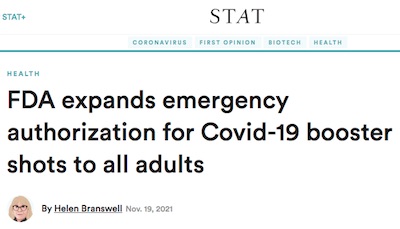
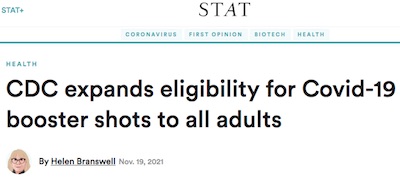 And as of this afternoon, the US FDA’s advisory committee has expanded the Emergency Use
Authorization for boosters of both Pfizer and Moderna to all persons over age 18 who are
more than 6 months past their initial 2 shots. [7] Acting FDA
Commissioner Woodcock then endorsed the decision, officially granting EUA for all-adult boosters.
And as of this afternoon, the US FDA’s advisory committee has expanded the Emergency Use
Authorization for boosters of both Pfizer and Moderna to all persons over age 18 who are
more than 6 months past their initial 2 shots. [7] Acting FDA
Commissioner Woodcock then endorsed the decision, officially granting EUA for all-adult boosters.
In a remarkable display of speed, the CDC’s ACIP committee within hours voted 11 – 0 to endorse that. Then CDC Director Walensky immediately ratified their decision, adding the policy to CDC medical practice guidelines. [8]
So there ya go, it’s a done deal in the US: boosters all around for adults, and kids 5 – 18 can get the first 2 shots in the series. (Pediatric vaccines for ages 0 to 5 years are still in the pipeline.)
Addendum 2021-Nov-20: The media slowly catch up
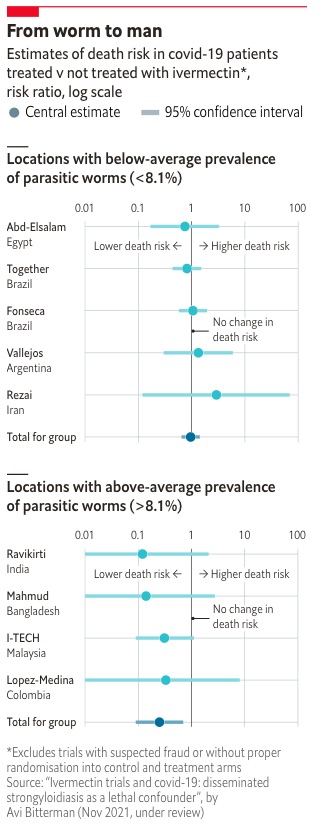 Today we notice that The Economist has noticed. [9] While
most of their article is behind the usual execrable paywall, the graphic indicates they’ve
found a preprint of Avi Bitterman on the result above. That’s… mildly impressive:
I haven’t found Bitterman’s preprint myself, yet. So… good job, Economist?
Today we notice that The Economist has noticed. [9] While
most of their article is behind the usual execrable paywall, the graphic indicates they’ve
found a preprint of Avi Bitterman on the result above. That’s… mildly impressive:
I haven’t found Bitterman’s preprint myself, yet. So… good job, Economist?
They’re leading with a forest plot, in the usual way:
- Each row is a clinical trial.
- Trials with suspected fraud, which are the majority of ivermectin studies, have been excluded. This alone should make you deeply suspicious of the rest!
- The circle represents the central estimate of the risk ratio between ivermectin arms and non-ivermectin arms of trials. Basically it’s the mean or median or something of the risk ratio.
- The whiskers represent the 95% confidence interval.
- You’d like to see both the central estimate and the upper confidence limit below 1 to believe there is solid evidence that ivermectin is beneficial.
- They’ve separated the trials from countries with low Strongyloides rates from those with higher rates; basically non-wormy vs wormy.
The result shows that ivermectin does nothing for COVID-19 patients who do not already have a worm infestation.
Conclusions:
- You have worms? Ivermectin is for you, COVID-19 or not.
- You have COVID-19, but not worms? Ivermectin is junk; get fluvoxamine or molnupiravir or paxlovid or monoclonal antibodies or dexamethasone or… something known to work.
- You weren’t vaccinated?! Remind me again: why is that?
Notes & References
1: FDA Staff, “Why You Should Not Use Ivermectin to Treat or Prevent COVID-19”, FDA Consumer Updates, retrieved 2021-Nov-19. ↩
2: Reuters Staff, “Fact Check-Merck’s experimental COVID-19 antiviral drug is not ‘repackaged ivermectin’”, Reuters Fact Check, 2021-Oct-07. ↩
3: Reuters Staff, “Fact Check-Molnupiravir, Merck’s newly UK-approved COVID-19 antiviral drug, is not ‘ivermectin re-hashed’”, Reuters Fact Check, 2021-Nov-05. ↩
4: Malaysian Ministry of Health, “IVERMECTIN TREATMENT EFFICACY IN COVID-19 HIGH RISK PATIENT (I-TECH STUDY)”, Ministry of Health Media Statements, 2021-Nov-03. NB: The English-language version is at the bottom, so scroll down if that’s the language you want. ↩
5: SA Siskind, “Ivermectin: Much More Than You Wanted To Know”, Astral Codex Ten Blog, 2021-Nov-07. ↩
6: M Riaz, et al., “Prevalence, risk factors, challenges, and the currently available diagnostic tools for the determination of helminths infections in human”, Eur Jnl Inflamm 18 (2020), pp 1-15. DOI: 10.1177/2058739220959915 ↩
7: H Branswell, “FDA expands emergency authorization for Covid-19 booster shots to all adults”, STAT News, 2021-Nov-19. ↩
8: H Branswell, “CDC expands eligibility for Covid-19 booster shots to all adults”, STAT News, 2021-Nov-19. ↩
9: Economist Staff, “Ivermectin may help covid-19 patients, but only those with worms”, Daily Chart in The Economist, 2021-Nov-18. ↩

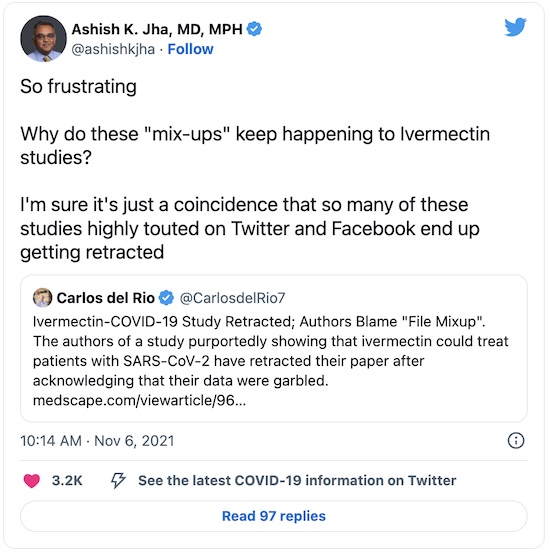
Gestae Commentaria
So it seems that the NIH took ivermectin more seriously and included it in the ATCIV 6 trial (https://activ6study.org/) with a proper design . First readout (not sure if they also have a futility analysis first, as ACTIV3 does) should come before Christmas. Hopefully this will settle the story once and for all.
Well… I guess I’m glad they’re doing a definitive study.
But really, to me the case is now pretty much closed: most of it fraught with fraud & incompetence, the remainder either explained by worm infestations or null result. I wonder how they treat the ethics of witholding SoC in favor of ivermectin?
I just looked through the ACTIV6 web site (thanks for the pointer!), and they say there are no approved drugs for mild to moderate COVID-19. I but there’s a meeting in about 10 days re molnupiravir approval, and paxlovid will almost certainly follow in December. And molnupiravir is already approved in the UK. So maybe time to update the ACTIV6 web site.
Thanks again, and as always for this! (It’s not a crummy little blog, and I have serious stats friends who also read it.)
Always happy to hear from you, Pablo. Glad you liked it.
Uh oh. “Serious stats friends” read this? I gotta up my game! :-)